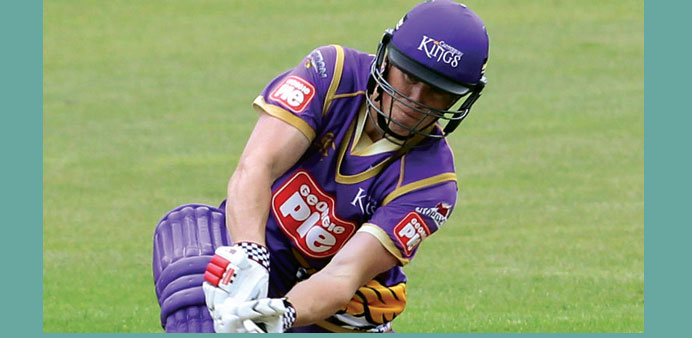Reuters/Wellington
Uncapped batsman Henry Nicholls has been called into New Zealand’s one-day squad for the start of the five-match series against Sri Lanka, while pace duo Trent Boult and Tim Southee have been rested. Canterbury lefthander Nicholls was included in the 14-man squad for the first three ODIs after impressing coach Mike Hesson and fellow selector Gavin Larsen with his performances over the last 12 months.
The 24-year-old, who was the second top run-scorer in last season’s domestic one-day competition, topped the averages (75.66) and scored an unbeaten 144 in the unofficial ‘test’ between New Zealand and Sri Lanka ‘A’ sides in October.
Nicholls continued that strong form in the domestic Twenty20 competition and looks set to reap his rewards with an ODI debut at his home ground of Hagley Oval.
“Henry has earned his spot after consistent performances over the last 12 months and during the New Zealand A campaign, he was exceptional across all forms,” Hesson told reporters.
“He is a player who has got class and he’s a player we want exposed to the international scene sooner rather than later so we’re excited to see how he goes.”
Hesson said opening bowlers Boult and Southee, who formed a deadly tandem during the World Cup earlier this year as New Zealand made their first final, would be rested. Boult will miss the first three games in Christchurch on Dec. 26 and 28 and in Nelson on Dec. 31. Southee will be available for the Nelson game, with Matt Henry selected for the first two games.
“Both Trent and Tim by the time we get to the next test would have played five tests in a row,” Hesson said.
“It’s a long season and we need some fresh legs steaming in at the first ODI.”
Injured all-rounders Corey Anderson, Jimmy Neesham and Grant Elliott were not considered for selection.Elliott, who broke his arm in a domestic match, could be back playing during the Christmas period, Hesson said.
Anderson and Neesham have been struggling with back injuries and their bowling has been limited, he added.
“Corey is starting to increase his loads (and) it is likely he could be considered for the T20 as a batsman,” Hesson said.
“We are hopeful by the back end of the season he will play a role with the ball. In terms of James, he’s a long way off from bowling at the moment but it’s nice to see him back playing cricket again.”
The final two games of the series are on January 2 in Nelson and Jan. 5 in Mount Maunganui before Sri Lanka end their tour with two Twenty20 internationals.
“At home we’ve been hard to beat so I think winning the one-day series is an expectation we should have of ourselves,” Hesson added.
“We know Sri Lanka have got some talented batsmen and some pretty wily campaigners with the ball but we certainly rate our own skills in New Zealand conditions.”
Squad: Brendon McCullum (captain), Doug Bracewell, Martin Guptill, Matt Henry (first two matches), Mitchell McClenaghan, Adam Milne, Henry Nicholls, Luke Ronchi, Mitchell Santner, Ish Sodhi, Ross Taylor, Kane Williamson, George Worker, Tim Southee (third match only)
Australia schedules more
domestic pink ball matches
Flushed with the success of the inaugural day-night test match, Cricket Australia has further embraced the innovation by scheduling another pink ball round of four-day Sheffield Shield matches for mid-February.
More than 123,000 fans passed through the gates at Adelaide Oval over the three days of last month’s experimental test against New Zealand, a record for a non-Ashes match.
That far outstripped the paltry crowds for the test against West Indies last week at Bellerive Oval in Hobart as well as the Brisbane and Perth matches against the Black Caps—all played in more traditional daylight hours.
Round seven of the interstate Sheffield Shield championship will now take place under lights with the WACA in Perth, the Gabba in Brisbane and Adelaide all hosting day-night matches starting on February 14.
“The public’s response to the first day-night test was overwhelmingly positive and we’ve now had some time to evaluate feedback from everyone involved in the match,” Cricket Australia’s Sean Cary said in a news release.
“As we look ahead to future international seasons and the prospect of playing more test cricket under lights, we want to give our players more opportunities to play with the pink ball.
“These matches will be used as part of our work to keep refining the ball in close consultation with Kookaburra.”
Australia and New Zealand players reported that there was more movement from the pink ball under lights in Adelaide, while concerns that it deteriorates more quickly than the red ball have also been expressed.
Such reservations look like doing nothing to dampen the enthusiasm of supporters of day-night cricket for an innovation they see as a potential saviour of the longest form of the game.
Chief among those supporters are Cricket Australia and its chief executive James Sutherland, who has suggested that two tests could be played under lights when Pakistan and South Africa tour next year.
There has also been widespread support from around the world of cricket with International Cricket Council chief David Richardson and India skipper Virat Kohli among those backing the concept.
Round one of Sheffield Shield in October was also played under the lights with matches at Adelaide Oval, Melbourne Cricket Ground and at Bellerive Oval.

Henry Nicholls
